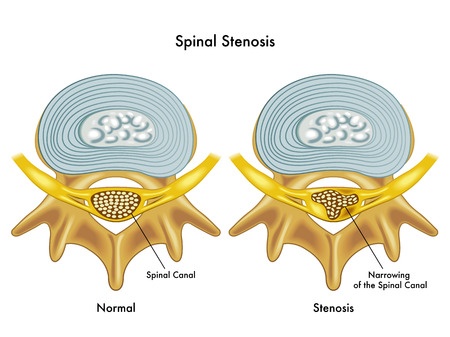An estimated 31 million Americans suffer from back pain at any given time.
It is no surprise then, that lower back pain is the leading cause for missed work and disability claims among employed individuals across the country.
While the causes of back pain vary greatly, one of the common origins of discomfort in the back is spinal stenosis, or the narrowing of the spinal column in adults. If you suffer from back pain, it may be beneficial to understand what is spinal stenosis, what causes spinal stenosis, and what types of spinal stenosis pain relief may be available to you.
What is spinal stenosis?
Spinal stenosis is a condition of the spinal cord and nerve roots located in the spine caused by narrowing. When these components of the spine are compressed, individuals experience a pinching of the spinal cord or nerve roots which can lead to immense pain in and around the back, legs, neck, or shoulders.

What causes spinal stenosis?
What causes spinal stenosis can be a difficult question to answer, but for most causes of spinal stenosis can be linked to the following:
Spinal stenosis symptoms
Most often, individuals experience pain in the back, legs, arms or shoulders as spinal stenosis symptoms. Additionally, individuals may also encounter clumsiness or frequent falling, difficulty walking, or tingling in the legs.
Some additional symptoms of spinal stenosis may include numbness of the limbs, hot or cold feelings in the legs, or problems with their feet.
Who is at risk?
While any individual could suffer from spinal stenosis, some are more at risk than others. Those born with a narrow spine are more likely to experience further narrowing as they age.
Additionally, women and those 50 years and older are more apt to experience symptoms of spinal stenosis.
Finally, those with previous injuries to the back or spine have a higher chance of having the spinal canal narrow over time.
Spinal stenosis pain relief

If you suffer from spinal stenosis, there are methods to relieve pain associated with symptoms. Simple lifestyle changes such as a change in posture can have a positive impact on how much discomfort you experience over time.
Additionally, rest in between light activities or exercise is important in keeping your back healthy. Oftentimes, steroids can help relieve the pain associated with spinal stenosis, by not only softening the spine ligaments but also through reducing inflammation and swelling.
Regardless of the cause of your condition, spinal stenosis treatment is most effective when it is discussed with a spinal health professional first. At Silver State Spine Care, we understand how painful spinal stenosis can be, and we work with our patients to help them understand each of their non-surgical options for spinal stenosis treatment.
Contact us today to discuss your spine care needs, and to get assistance with managing your spinal stenosis.


